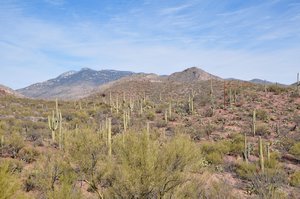Advertisement
Published: March 23rd 2010

 Back in Arizona
Back in Arizona
The saguaro cactus defines the Sonoran Desert, just as the Joshua Tree defines the Mohave Desert.This travelblog covers a lot of distance and time. After leaving our son Nick and the Salton Sea in southern California we headed back to Tucson and the Sonoran Desert. After re-provisioning and some vehicle maintenance in Tucson, we headed south some 40 miles to Patagonia Lake State Park, one of our favorite Arizona State Parks. The plan was to meet Peter and Trudy Brussard and their two dogs, Modoc and Katie, who would be arriving after a quick trip south from their home in Reno, NV. Peter and Trudy travel in a 17 foot Big Foot trailer pulled by a diesel GMC truck. The plan was to travel down the Rio Grande Valley to Brownsville, TX while spending some time at three state parks that Lynn and Jon had really enjoyed in the previous winter. At Brownsville, we would travel to the El Cielo Biosphere Preserve in the state of Tamaulipas, Mexico, sans dogs and trailers. The captions of the following pictures tell the tale.
Note: if you want more information and pictures covering several state parks (Patagonia Lake, Seminole Canyon, and Falcon) than is provided here check several of our travelblogs from winter 2009. Specifically, see
Patagonia Lake SP and

 Back in Arizona
Back in Arizona
A barrel cactus is one of a great diversity of cacti found in the Sonoran desert..
Terrapass
Advertisement
Tot: 0.278s; Tpl: 0.015s; cc: 10; qc: 61; dbt: 0.1431s; 1; m:domysql w:travelblog (10.17.0.13); sld: 1;
; mem: 1.1mb

 Back in Arizona
Back in Arizona
 Back in Arizona
Back in Arizona




































